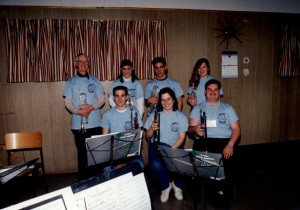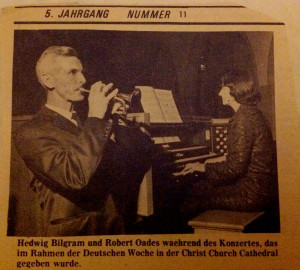… and teaching
 Any student who encountered Bob Oades learned early on that he did not offer a quick path to musical success. He spoke often of the 10 years of hard work that he felt were required to turn a person into a professional musician. He was delighted to see that others had studied this idea of deliberate practice leading to expertise, with some more recent writers going so far as to talk about a 10,000-hour rule. The upshot: start practicing and keep practicing.
Any student who encountered Bob Oades learned early on that he did not offer a quick path to musical success. He spoke often of the 10 years of hard work that he felt were required to turn a person into a professional musician. He was delighted to see that others had studied this idea of deliberate practice leading to expertise, with some more recent writers going so far as to talk about a 10,000-hour rule. The upshot: start practicing and keep practicing.
This idea that intelligently-applied effort would improve one’s musicianship was reflected in what Bob said to his students, and the exercises he assigned. Students in University of Ottawa Wind Ensemble would recall being admonished to “Die, die, die!” or “Suffer!” when playing pianissimo. To achieve a remarkable pianissimo, one should practice long tones to the point where the sound disappears, throughout the range of one’s instrument. At the other end of the dynamic spectrum, loud notes should always be controlled, never crass.
Knowledge of one’s instrument was essential. A typical wind ensemble rehearsal would start with a scale cycle – major scale, relative harmonic minor, melodic minor, major scale, and so on – that (to our relief) eventually ended up back at the initial scale. “Three scale cycles, and you’ve covered all your scales.” Next would come the arpeggiated dominant sevenths, or diminished sevenths. Fumbling over these would get you “the look” – frowning while looking over the frame of his ’70s-era eyeglasses.
Trumpet students were given a steady diet of mouthpiece and lip buzzing, lip slurs, Arban’s, Concone, studies, and repertoire. You could certainly provide input into what repertoire you wanted to work on, but if Bob felt it was not going to benefit you musically, he would say as much. Music was to be approached lyrically, with great attention given to phrasing, taking breaths in the appropriate spots. “Use your natural skill and cunning,” he instructed.
If he thought your embouchure was going to present problems in the future, he might suggest a few changes: “Start with em.” This is the one area of his pedagogy that contrasts sharply with the current approach to trumpet. Having gone through an embouchure change of his own, mid-career, he didn’t consider it a casual endeavour, but knew the benefits such a change might bring.
 Though familiar with a variety of horns, Bob believed you could never be really confident, particularly in the upper register, unless you could play your repertoire on the B♭ trumpet. His recommended progression was from B♭ to E♭/D trumpet. “This horn lets you play the Haydn, the Hummel, and all the Baroque repertoire.” After working with the E♭/D trumpet, you could progress to the piccolo trumpet. Throw in a C trumpet, although it’s only required if you’re pursuing an orchestral career, and you’re ready for anything. He also mentioned that playing cornet helped players better understand the early method books and band repertoire. Cornet playing was also good for developing a lyrical tone, but only if approached with the proper V-style mouthpiece common in the early days of that instrument.
Though familiar with a variety of horns, Bob believed you could never be really confident, particularly in the upper register, unless you could play your repertoire on the B♭ trumpet. His recommended progression was from B♭ to E♭/D trumpet. “This horn lets you play the Haydn, the Hummel, and all the Baroque repertoire.” After working with the E♭/D trumpet, you could progress to the piccolo trumpet. Throw in a C trumpet, although it’s only required if you’re pursuing an orchestral career, and you’re ready for anything. He also mentioned that playing cornet helped players better understand the early method books and band repertoire. Cornet playing was also good for developing a lyrical tone, but only if approached with the proper V-style mouthpiece common in the early days of that instrument.
When it came to mouthpieces, Bob had no desire to use anything other than the stock Bach 1½ C he had used for years. This set the bar high for students who might have been looking for that perfect mouthpiece for high playing. Equally important for one’s development was the idea of taking a day off playing each week. “This works wonders if you’re working hard on your playing.”
Trumpet students were taught to transpose everything – using the Caffarelli, Bordogni, and Sachse studies – which had the added benefit of making them capable of playing any part that might not be covered in an ensemble. This skill was also invaluable for future school music teachers.
Over lunch (which he always insisted on buying), Bob talked about the hiring spree that went on in Ontario school boards in the the 1950s – how teachers were hired at special job fairs held at hotels, particularly in Toronto. Some of these teachers proved to be excellent, but others were simply “operators” in search of a steady pay cheque. He felt that school music teaching was an honourable profession that should be backed by solid musicianship, not an occupation of last resort for frustrated musicians. He treated University of Ottawa students in the music education stream no differently from performance majors, and encouraged them to continue playing once their teaching careers were underway. Knowing what lay ahead for us in our professional and private lives, he urged us to practice as much as possible while in university. “You will never have this much time to practice – ever again,” he predicted, accurately.
Bob told the story of a famous brass player who appeared as a soloist in concert with the NAC Orchestra. After the performance, the soloist complimented Bob on his playing, and upon finding out that he taught at the university, warned him, “Don’t teach too well.” Bob was appalled at this remark; it was indicative of the exact opposite of how he approached teaching. He was pleased to pass on any and all instruction, and wanted his students to achieve, even surpass, what he had achieved. Students knew well that if his office phone rang during a lesson, he would offer the caller a cheerful greeting followed by “I’m teaching.”


My first music teaching position after graduating from Queen’s U was at an international school in Bogota, Colombia. Within three months of settling in to my new “home” with three other Queen’s grads, our house was robbed (while we were settling down for the night!). Among the many valuables taken were my Bflat Bach and C Yamaha trumpets. Upon hearing of the theft, Mr. Oades offered to find a replica Bflat Bach and get it to my parents, which he did. I’ll never forget this act of kindness as well as his passion for trumpet playing. I will continue to miss him dearly.